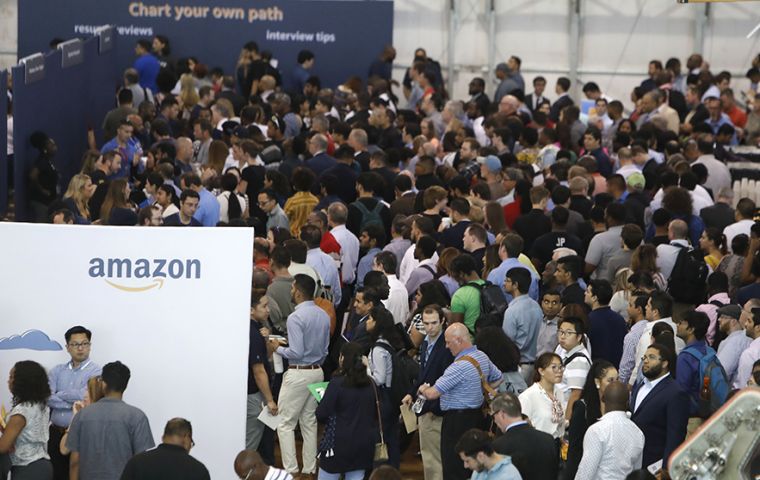MercoPress. South Atlantic News Agency
US unemployment at a record 50-year low in September, but manufacturing fell sharply
 Labor Department's monthly employment report also showed that the risks to the longest economic expansion on record remained tilted to the downside
Labor Department's monthly employment report also showed that the risks to the longest economic expansion on record remained tilted to the downside The U.S. unemployment rate dropped to near a 50-year low of 3.5per cent in September, with job growth increasing moderately, suggesting the slowing economy could avoid a recession for now despite trade tensions that are hammering manufacturing.
The Labor Department's closely watched monthly employment report on Friday, however, contained reminders that the risks to the longest economic expansion on record remained tilted to the downside. Wage growth stagnated and manufacturing payrolls declined for the first time in six months. The retail and utilities sectors also continued to shed jobs.
The report followed a string of weak economic reports, including a plunge in manufacturing activity to more than a 10-year low in September and a sharp slowdown in services industry growth to levels last seen in 2016, that heightened fears the economy was flirting with a recession.
“The unemployment rate usually rises ahead of a recession, so a fresh decline pushes out the timeline for any potential recession into late 2020 at the earliest,” said Josh Wright, chief economist at iCIMS in New York.
The two-tenths of a percentage point drop in the unemployment rate from 3.7per cent in August pushed it to its lowest level since December 1969. The jobless rate, which had been stuck at 3.7per cent for three straight months, declined even as 117,000 people entered the labor force last month.
Nonfarm payrolls increased by 136,000 jobs last month, the government's survey of establishments showed. The economy created 45,000 more jobs in July and August than previously estimated. Economists polled by Reuters had forecast payrolls would increase by 145,000 jobs in September.
September's job gains were below the monthly average of 161,000 this year, but still above the roughly 100,000 needed each month to keep up with growth in the working-age population. The smaller household survey from which the unemployment rate is derived showed a jump of 391,000 in employment in September.
These factors, together with benign wage inflation, are likely to prompt the Federal Reserve to cut interest rates at least one more time this year, economists said. The U.S. central bank cut rates last month after reducing borrowing costs in July for the first time since 2008, to keep the economic expansion, now in its 11th year, on track.
Fed Chair Jerome Powell reiterated on Friday that the economy was “in a good place,” adding that “our job is to keep it there as long as possible.”
The dollar was little changed against a basket of currencies. Prices of U.S. Treasuries rose marginally. Stocks on Wall Street were trading higher.
Last month's decline in manufacturing payrolls was led by the automotive sector, which lost 4,100 jobs. Further losses are likely if a strike by General Motors workers continues.
Construction employment increased by 7,000 jobs after rising by 4,000 in August. Retail payrolls fell by 11,400 jobs, marking an eighth straight monthly drop.
Government employment increased by 22,000 jobs in September after surging by 46,000 in August. Hiring was boosted by state and local governments. Only 1,000 workers were hired last month for the 2020 Census. Government payrolls have increased by 147,000 over the year, driven by local governments.




Top Comments
Disclaimer & comment rulesCommenting for this story is now closed.
If you have a Facebook account, become a fan and comment on our Facebook Page!